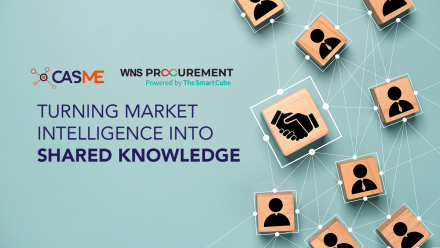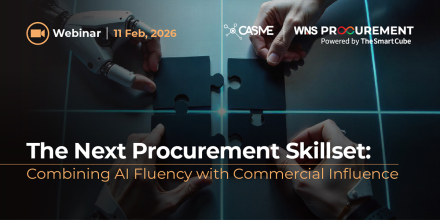
Since the introduction of ChatGPT versions 3.5 and 4, the surge in interest surrounding Artificial Intelligence (AI) has been nothing short of extraordinary. The excitement is palpable, but amid the promises and hype, there's a need for Procurement to discern practical realities from the idealistic vision often associated with AI.
During a webinar ‘Separating AI Hype from Reality in Procurement’ hosted by CASME and The Smart Cube, more than 200 procurement professionals joined a panel of industry experts who engaged in a thought-provoking discussion on the current and future implications of AI in procurement. This lively discussion touched upon various aspects - from current adoption rates to real-world applications and challenges.
Watch the full webinar on demand, and enjoy reading the highlights and benchmarking poll results below to discover what it means for Procurement to be at the forefront of this ‘supercharged’ transformation.
Is Procurement ready for AI?
Acknowledging the shift towards more intelligent ‘bots’ and virtual systems, and the need for procurement efficiency and valuable insights, a benchmarking poll kicked-off the webinar to reveal 71% of the audience is either exploring or preparing for AI adoption in procurement.
With 50% in the exploration phase, CASME’s Procurement Content Director, Graham Crawshaw, confirms this poll result mirrors the investigative approach being taken by many CASME members. A few risk-averse organisations have blocked their employees’ access to ChatGPT, choosing instead for the functions to use third-party systems with integrated AI functionality.
Live Poll: How prepared is your organisation regarding the adoption of AI for procurement activities?
(Select one option)
Insights from the panel
Sharing his perspective as Head of Procurement & Operations at Allianz, Raoul Gröning highlights the existing reality of AI in his organisation, emphasising its practical applications in analysing extensive data sets in seconds and enhancing new supplier investigations. He provides a specific example of using an in-house generative AI system ‘AllianzGPT’, a tailored version of ChatGPT, for generating structured supplier reports without compromising confidentiality and data security. These reports not only enhance negotiations but also assist in detecting publicised issues, such as quality; improving Procurement’s credibility and leaving stakeholders impressed with their depth and quality.
Procurement Director at The Clorox Company, Ashish Gupta, echoes the sentiment that AI is on a journey to becoming a tangible asset in procurement activities. He discusses the exploration phase at Clorox, where third-party applications are being leveraged for tasks such as real-time market information in category strategy and data cleansing in spend analytics.
Unlike the speculation that surrounded blockchain, AI is expected to see more rapid and practical adoption, due to its practicality and ease of implementation.
Starting the journey – curious but cautious
Many in Procurement have experimented with some form of AI, trying to understand the perceived and actual issues and benefits it can bring to their day-to-day work.
Data security and quality concerns about the use of AI tools, demonstrates the need for organisations to strike a balance between curiosity and caution – whether that’s exploring end-user solutions through third-party applications for spend analytics, or developing in-house generative AI technologies with ‘bespoke’ ChatGPT, or using off -the-shelf systems with integrated AI functionality such as ERP and risk management systems.
There’s a need to learn from experiments, fine-tune AI applications, and customise them to meet specific procurement needs. With all new concepts, Ashish advises Procurement to be limitless in your thinking, but mindful in your execution.
Within Clorox, several criteria are used to assess new AI technology, including:
- Experience: how does the technology enable/improve a process or enhance productivity?
- Subtraction: to what extent does the technology remove manual or time-consuming activities to enable Procurement to add real value?
As explained by Omer Abdullah, The Smart Cube’s Co-Founder, the scarcity and expense of AI-knowledgeable personnel, however, is a significant challenge. The increasing demand for AI experts is making it difficult for organisations to secure the necessary talent. Despite this hurdle, the consensus is that AI adoption in procurement is inevitable, given its potential benefits.
Short-term expectations: 2024
AI’s capability advancement — which has changed the emphasis from automation, to now focus on combining and interpreting data — is now mimicking higher-order human intelligence. The panel agree that this shift marks a pivotal phase for the integration of AI into procurement processes.
AI-driven procurement technologies are expected to alter the focus and actions of procurement teams during the next 12 months - with a spotlight on technology that addresses tactical and operational challenges, indicating a strong interest in leveraging AI for data-intensive activities.
Confirmation of this is reinforced during a live poll, when spend analytics, contract management and supplier discovery are identified by the audience as being the top three procurement processes expected to benefit most from AI.
Live Poll: Which 3 procurement processes in your organisation are likely to benefit most from the implementation of AI?
Virtual buying assistants – shaping the future
Innovation is a catalyst for positive change and improvements in various aspects of life. Take the internet for example, people tend to use Google as second nature for research. Now there’s an alternative - ChatGPT - a chatbot tool which Procurement can adapt and use to its advantage to manage procurement processes and connect people with technology that improves efficiencies across functions.
According to Raoul, the emergence of self-teaching virtual assistants (VAs) is a transformative force that has the potential to redefine how Procurement operates – supporting tactical procurement activities such as spend analysis, invoicing and contract analysis - provided the correct prompts are used.
Furthermore, by uploading procurement guidelines into another self-engineered chatbot that uses integrated AI modules, to create a procurement assistance tool for stakeholder requests. The bot can respond with ‘what to do now’ guidance regarding the procurement process, or reveal an existing in-house procurement solution.
Having highly personalised AI-powered buying assistants that follow voice and text commands to handle specific tasks, extract insights from vast amounts of data and learn iteratively, will enhance the overall experience of Procurement, stakeholders and suppliers.
Regulatory landscape: A critical factor
Containment concerns are real, especially for generative AI (GenAI) that focuses on creating systems capable of generating new and creative content in a human-like manner. While current AI may not require stringent security, future AI-driven viruses that adapt in real-time to avoid detection could potentially move across systems and turn rogue.
Regulation of AI is important, as this could significantly impact the adoption landscape. Ashish raises awareness about the anticipated European AI Act, and the potential classification of AI as a regulated product. The priority of this law being to ensure that AI systems used in the EU are safe, transparent, traceable, and overseen by people, rather than by automation, to prevent harmful outcomes.
Future horizons
With even more productive AI tools expected, Omer believes that the focus is likely to be on supporting the strategic aspects of procurement. Ashish agrees that this could include supply chain mapping of Tier 2 and Tier 3 suppliers, risk management, and multifaceted insights to provide a deeper understanding of procurement data.
Improvements in machine learning, could potentially lead to VAs taking over tasks autonomously, without being prompted. Raoul believes that it’s even possible that AI will play a more significant supporting role in negotiations, with chatbots giving hints for supplier questions and using the enhanced ability of voicebots to analyse and detect nervousness and untruths in spoken language.
Will bots negotiate with bots in future? Perhaps for low-cost tactical purchases, in which AI can replace technical skills. But for complex negotiations, where there’s a need to contextualise, understand the outcomes and relationships, the human element is still required. As procurement professionals, we’re inherently people-oriented; requesting collaboration, partnerships and relationships built on trust.
Embracing the human touch
It would be hypocritical of Procurement to demand the use of AI-applications among the organisation’s suppliers, without embracing (the capabilities of) AI for the function itself.
AI implementation is inevitable, and the role of the procurement team will change. The consensus is that while technical skills are crucial, the future will demand a focus on the ability to contextualise outcomes, build meaningful relationships, and understand the business.
Procurement must focus on delivering added value through business ‘soft’ skills rather than relying on technical and administrative skills that can be undertaken by AI.
Webinar poll results confirm the importance of adapting to the changing nature of work. Progress is expected in three main ways – through increased automation, greater understanding of organisational spend and ability to deliver additional non-monetary value to the organisation.
Live Poll: What will be the top 3 impacts of AI on the future of Procurement?
(Select 3 future impacts)
Striking the balance
With the right approach, there are compelling reasons for Procurement to embrace AI as a catalyst for positive change. To survive and thrive, there is no other choice in a future where technology will play an increasingly essential role in business operations.
Despite challenges in acquiring resources and concerns about regulations, the next 12 months are expected to witness accelerated innovations and opportunities, with virtual assistants taking centre stage.
Procurement professionals should be poised to redefine their roles, focusing on relationships, strategy, and business understanding. Procurement teams need to gear up for a future where AI becomes an integral part of their operations, shaping a new era of efficiency, learning, and strategic decision-making.
Back to News



